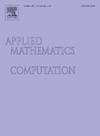Decoding rhythmic complexity: A nonlinear dynamics approach via visibility graphs for classifying asymmetrical rhythmic frameworks of Turkish classical music
IF 3.5
2区 数学
Q1 MATHEMATICS, APPLIED
引用次数: 0
Abstract
The non-isochronous, hierarchical rhythmic cycles (usuls) of Turkish Classical Music (TCM) exhibit emergent temporal structures that challenge conventional rhythm analysis based on metrical regularity. To address this challenge, this study presents a complexity-oriented framework for usul classification, grounded in nonlinear time series analysis and network-based representations. Rhythmic signals are processed through energy envelope extraction, diffusion entropy analysis, and spectral transformations to capture multiscale temporal dynamics. Visibility graphs (VGs) are constructed from these representations to encode underlying structural complexity and temporal dependencies. Features derived from VG adjacency matrices serve as complexity-sensitive descriptors and enable high-accuracy classification (0.99) across 40 usul classes and 628 compositions. Energy envelope-derived graphs provide the most discriminative information, highlighting the importance of amplitude modulation in encoding rhythmic structure. Beyond classification, the analysis reveals self-organizing patterns and signatures of complexity, such as quasi-periodicity, scale-dependent variability, and entropy saturation, suggesting that usuls function as adaptive, nonlinear systems rather than metrically constrained patterns. The topological features extracted from the resulting graphs align with theoretical constructs from complexity science, such as modularity and long-range temporal correlations. This positions usul as an exemplary case for studying structured temporal complexity in cultural artifacts through the lens of dynamical systems. These findings contribute to computational rhythm analysis by demonstrating the efficacy of complexity measures in characterizing culturally specific rhythmic systems.
解码节奏复杂性:一种非线性动力学方法,通过可见性图分类土耳其古典音乐的不对称节奏框架
土耳其古典音乐(TCM)的非等时、分层节奏循环(通常)表现出新兴的时间结构,挑战了基于韵律规则的传统节奏分析。为了应对这一挑战,本研究提出了一个基于非线性时间序列分析和基于网络的表示的面向复杂性的常用分类框架。节奏信号通过能量包络提取、扩散熵分析和光谱变换处理,以捕获多尺度时间动态。可见性图(vg)是由这些表示构建的,用于编码底层结构复杂性和时间依赖性。来自VG邻接矩阵的特征可以作为复杂性敏感的描述符,并在40个常用类和628个组合中实现高精度分类(0.99)。能量包络图提供了最具判别性的信息,突出了振幅调制在编码节奏结构中的重要性。除了分类之外,分析还揭示了自组织模式和复杂性的特征,如准周期性、尺度相关变异性和熵饱和,这表明通常是自适应的非线性系统,而不是度量约束模式。从结果图中提取的拓扑特征与复杂性科学的理论结构一致,例如模块化和长期时间相关性。这通常是通过动态系统的镜头来研究文化文物中结构化的时间复杂性的典型案例。这些发现有助于计算节奏分析,证明复杂性措施在表征特定文化节奏系统方面的有效性。
本文章由计算机程序翻译,如有差异,请以英文原文为准。
求助全文
约1分钟内获得全文
求助全文
来源期刊
CiteScore
7.90
自引率
10.00%
发文量
755
审稿时长
36 days
期刊介绍:
Applied Mathematics and Computation addresses work at the interface between applied mathematics, numerical computation, and applications of systems – oriented ideas to the physical, biological, social, and behavioral sciences, and emphasizes papers of a computational nature focusing on new algorithms, their analysis and numerical results.
In addition to presenting research papers, Applied Mathematics and Computation publishes review articles and single–topics issues.

 求助内容:
求助内容: 应助结果提醒方式:
应助结果提醒方式:


